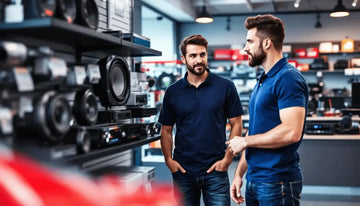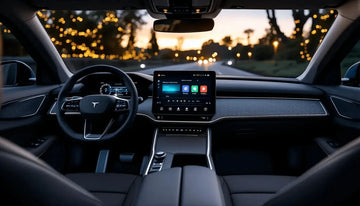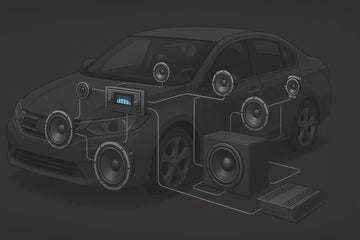Key Highlights
- Upgrade your car audio system to enhance your experience and enjoy high sound.
- Essential audio upgrades include car stereo systems, Bluetooth car adapters, car subwoofers, car speakers, car amplifiers, car audio accessories, car audio receivers, car equalizers, and car audio installation kits.
- Choosing the right car audio system for your vehicle is crucial for optimal sound quality and performance.
- Proper installation, tuning, and maintenance of your car audio system are essential to ensure maximum sound quality and longevity.
- Stay updated with the latest trends in car audio technology to enjoy the benefits of innovation in audio technology.
- Frequently asked questions about car audio systems, including the benefits of upgrading, DIY installation, choosing the right audio system, and more, will be addressed in this blog.
Car Audio Essentials: From Factory Systems to Audiophile Upgrades
Most of us spend hours each week in our vehicles. Whether it's a grinding commute or an epic road trip, a quality audio system transforms these moments from mundane to memorable. This guide walks you through meaningful car audio upgrades based on my 15 years of installing and testing car audio components across hundreds of vehicles.
Understanding Your Starting Point
Before spending a dime, assess what you're working with:
Your factory system isn't necessarily terrible. Many newer vehicles come with decent baseline systems that might only need targeted upgrades rather than complete overhauls. Press your ear against each speaker while someone plays music. Hear any rattling or distortion? Those speakers should top your replacement list.
The most common weaknesses in factory systems are:
- Thin midrange (vocals and instruments sound distant)
- Weak bass response (no impact in kick drums or bass guitar)
- Poor staging (sound seems trapped in the doors rather than spread across the dashboard)
Take a Sunday afternoon to listen critically to your system at different volumes. Note when the sound quality breaks down - this reveals your system's weaknesses.

Head Units: The Brain of Your System
The head unit (stereo) sends signals to everything else, making it the foundation of your audio chain.
When to keep your factory head unit:
- If it integrates with steering wheel controls and vehicle systems
- If replacing it would disrupt the dashboard aesthetic
- If you're primarily concerned with sound quality rather than features
When to replace your factory head unit:
- If it lacks connectivity options you need (CarPlay, Android Auto, Bluetooth aptX)
- If you want to add amplifiers and need preamp outputs
- If the interface frustrates you daily
Tech insight: Factory head units often apply aggressive equalization to compensate for cheap speakers. This can actually make aftermarket speakers sound worse initially. Quality head units provide cleaner signals and flexible tuning options.
For most modern vehicles with integrated displays, consider a DSP (Digital Signal Processor) instead of replacing the head unit. Units like the JL Audio Fix-86 can correct factory equalization while keeping all original functionality.

Speakers: Where Rubber Meets the Road
Speaker upgrades deliver the most immediate improvement to sound quality, but thoughtful selection matters more than simply buying expensive drivers.
Component vs. Coaxial Systems
Component systems separate woofers (usually in doors) from tweeters (typically mounted near A-pillars), creating better soundstaging. The crossover network ensures each driver handles appropriate frequencies.
Coaxial speakers combine both drivers in one unit, making them easier to install but compromising sound quality slightly.
If you're after significantly better sound with reasonable effort, install component speakers up front and quality coaxials in the rear locations.
Material Matters
- Poly or polypropylene cones offer good durability and balanced sound
- Silk dome tweeters provide smooth high frequencies with less fatigue
- Avoid metallic tweeters unless you've heard them in a similar vehicle

Installation Reality Check
Most factory speaker locations have acoustic compromises. Door speakers often fire into your legs rather than your ears. Consider these practical upgrades during installation:
- Sound deadening material in doors reduces vibration and improves midbass
- Angled speaker mounts can redirect sound toward listening positions
- Properly sealed enclosures prevent sound waves from canceling each other
Budget time for proper installation - rushing this step undermines even premium speakers.
Amplification: Power with Purpose
Factory head units typically provide 15-18 watts RMS per channel - barely enough for basic listening. External amplifiers deliver cleaner power at all volumes, particularly benefiting complex music.
Signs you need an amplifier:
- Music sounds compressed at higher volumes
- You want to run component speakers with proper crossovers
- You're adding a subwoofer (which absolutely requires amplification)
Class D vs. Class AB: Modern Class D amplifiers offer efficiency and compact size with excellent sound quality. They're ideal for most installations. Traditional Class AB amplifiers may offer marginally better sound quality for midrange and highs but generate more heat and consume more space.
Installation Essentials:
- Use proper gauge power wire (8-gauge minimum for systems over 600W)
- Mount in ventilated areas away from heat sources
- Install as close to speakers/subwoofers as practical to minimize signal loss
A quality 4-channel amplifier like the Alpine MRV-F300 can drive your entire system (front components, rear fills, and even a small subwoofer in bridge mode) while fitting under a seat.

Bass Management: Feeling the Music
Bass requires the most power and largest drivers to reproduce properly. A dedicated subwoofer creates the foundation that factory systems invariably lack.
Subwoofer Enclosure Types:
- Sealed boxes provide tight, accurate bass ideal for jazz, acoustic, and detail-oriented listening
- Ported enclosures offer more output with the same power, better for electronic, hip-hop, and rock
- Bandpass designs maximize output in specific frequency ranges at the cost of accuracy
Vehicle-Specific Solutions:
- Sedans: Consider trunk-mounted subwoofers with rear seat pass-throughs
- SUVs/hatchbacks: Floor-mounted enclosures that preserve cargo space
- Trucks: Under-seat powered subwoofers provide balance of performance and practicality
Pro tip: Position matters enormously. A properly positioned 8" subwoofer often outperforms a poorly placed 12" driver. Corner-loading (placing the subwoofer where three surfaces meet) maximizes output.
The JL Audio TwK 88 DSP allows precise integration of subwoofers with main speakers through advanced crossover and time alignment functions.

Sound Quality Optimization
All the equipment in the world won't help if it's not properly tuned. These fundamentals make dramatic differences:
Basic Tuning Steps:
- Set all tone controls to neutral positions initially
- Adjust crossover points (typically 80Hz between subwoofer and main speakers)
- Set time alignment if your head unit allows it
- Make subtle adjustments to equalization based on listening tests
Sound Deadening: Installing strategic sound deadening material:
- Reduces road and wind noise that mask musical details
- Prevents panel resonance that distorts bass
- Improves speaker performance by stabilizing mounting surfaces
Focus on doors first, followed by the floor and trunk/hatch areas. Even modest treatment yields noticeable improvements.

Troubleshooting Common Issues
Alternator Whine: This high-pitched noise that increases with engine RPM usually indicates a ground loop. Solutions include:
- Ensuring the amplifier ground connects directly to the chassis metal (not seat bolts)
- Using a ground loop isolator on RCA connections
- Running power and signal cables on opposite sides of the vehicle
Distortion at High Volumes:
- Check gain settings on amplifiers (most should be set at 1/3 to 1/2 maximum)
- Verify the head unit's internal amplifier isn't clipping
- Ensure speakers are properly powered for their sensitivity rating
Unbalanced Sound:
- Verify all fade/balance controls are centered
- Check for partially blown speakers by listening to each individually
- Consider basic time alignment to compensate for seating position

Real-World Recommendations
Budget-Friendly Essentials ($300-500):
- Speaker upgrade: Infinity Reference component system up front
- Sound deadening: Strategic application of Kilmat in doors
- Bass: Powered underseat subwoofer like Kicker Hideaway
Mid-Range Sweet Spots ($800-1200):
- 4-channel amplifier: Alpine MRV-F300
- Front speakers: Morel Maximo component system
- Subwoofer: JL Audio 10" in sealed enclosure
- Sound deadening: Complete door treatment and partial floor coverage
Audiophile Approach ($2000+):
- Signal processor: Helix DSP.3
- Amplification: JL Audio XD-series for components, HD-series for subwoofer
- Front speakers: Focal Access component system
- Subwoofer: Audiofrog G-series in custom enclosure
- Complete sound-deadening package

Conclusion
The best car audio systems are built thoughtfully, not just with expensive components. Start with the weakest links in your current setup, improve them methodically, and take time with installation and tuning. A properly executed $800 system will outperform a poorly installed $3000 system every time.
Remember that car audio is highly personal - what sounds perfect to one person might not impress another. Trust your ears over specifications, and be willing to make adjustments based on your listening preferences.
Looking for installation help? Most cities have enthusiast groups that meet regularly to share advice and sometimes even help with installations. These communities often provide more honest guidance than retail shops focused on selling specific brands.





